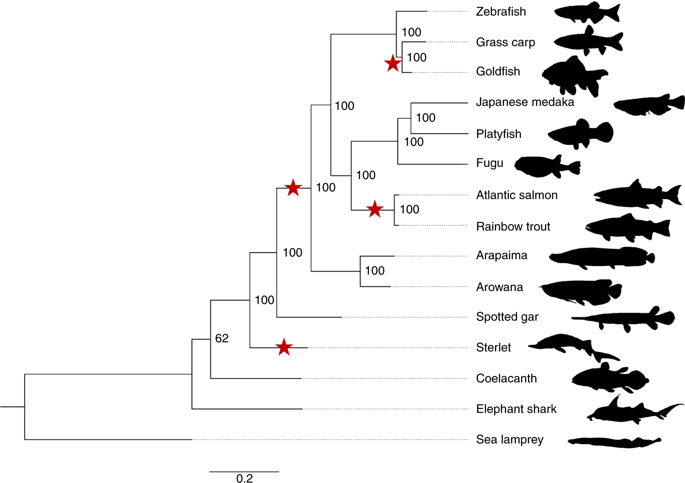Nature Ecology & Evolution ( IF 13.9 ) Pub Date : 2020-03-30 , DOI: 10.1038/s41559-020-1166-x Kang Du 1, 2 , Matthias Stöck 3 , Susanne Kneitz 1 , Christophe Klopp 4, 5 , Joost M Woltering 6 , Mateus Contar Adolfi 1 , Romain Feron 7 , Dmitry Prokopov 8 , Alexey Makunin 8 , Ilya Kichigin 8 , Cornelia Schmidt 1 , Petra Fischer 1 , Heiner Kuhl 3 , Sven Wuertz 3 , Jörn Gessner 3 , Werner Kloas 3 , Cédric Cabau 4, 5 , Carole Iampietro 9 , Hugues Parrinello 10 , Chad Tomlinson 11 , Laurent Journot 10 , John H Postlethwait 12 , Ingo Braasch 13 , Vladimir Trifonov 8 , Wesley C Warren 14 , Axel Meyer 6 , Yann Guiguen 15 , Manfred Schartl 2, 16, 17

|
Sturgeons seem to be frozen in time. The archaic characteristics of this ancient fish lineage place it in a key phylogenetic position at the base of the ~30,000 modern teleost fish species. Moreover, sturgeons are notoriously polyploid, providing unique opportunities to investigate the evolution of polyploid genomes. We assembled a high-quality chromosome-level reference genome for the sterlet, Acipenser ruthenus. Our analysis revealed a very low protein evolution rate that is at least as slow as in other deep branches of the vertebrate tree, such as that of the coelacanth. We uncovered a whole-genome duplication that occurred in the Jurassic, early in the evolution of the entire sturgeon lineage. Following this polyploidization, the rediploidization of the genome included the loss of whole chromosomes in a segmental deduplication process. While known adaptive processes helped conserve a high degree of structural and functional tetraploidy over more than 180 million years, the reduction of redundancy of the polyploid genome seems to have been remarkably random.
中文翻译:

鱼genome体基因组序列和节段性二倍体化的机制。
鱼似乎被及时冻结了。这个古老鱼类谱系的古老特征使它处于约30,000种现代硬骨鱼种类基础的重要系统发育位置。此外,st鱼是众所周知的多倍体,为研究多倍体基因组的进化提供了独特的机会。我们为小,Acipenser ruthenus组装了高质量的染色体水平参考基因组。我们的分析表明,蛋白质进化速度非常低,至少与脊椎动物树其他深分支(如腔棘鱼)的进化速度一样慢。我们发现了在整个st鱼血统进化的早期侏罗纪发生的全基因组重复。多倍体化之后,基因组的重倍体化包括部分重复数据删除过程中整个染色体的丢失。尽管已知的适应性过程在超过1.8亿年的时间里帮助保存了高度的结构和功能性四倍体,但多倍体基因组冗余的减少似乎是随机的。











































 京公网安备 11010802027423号
京公网安备 11010802027423号